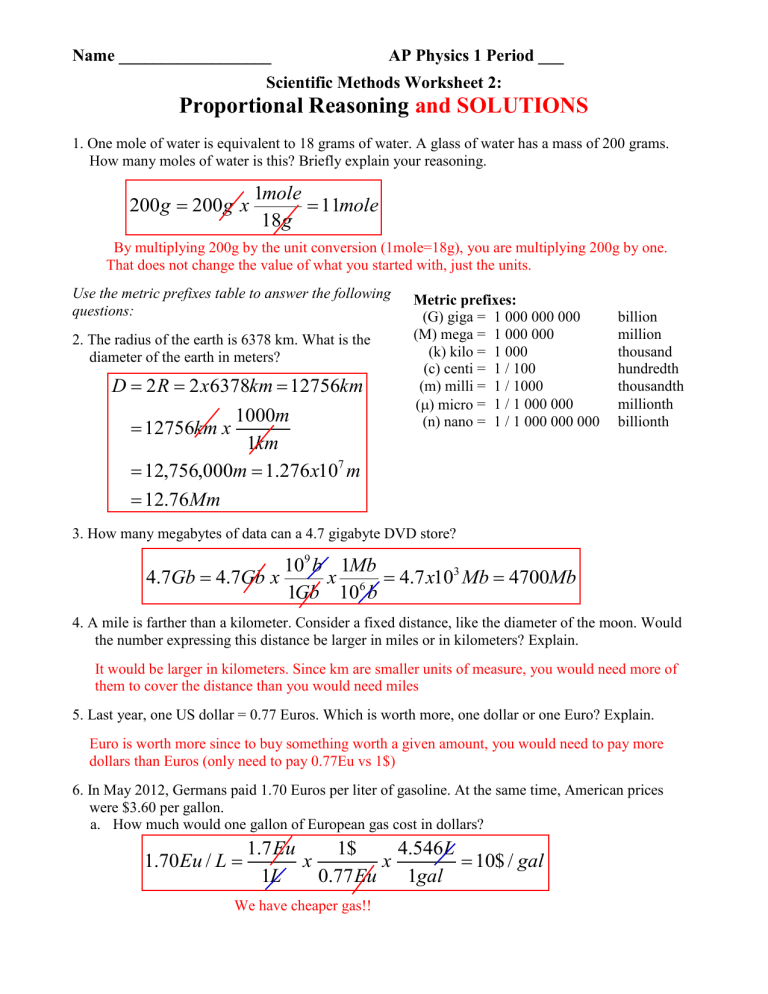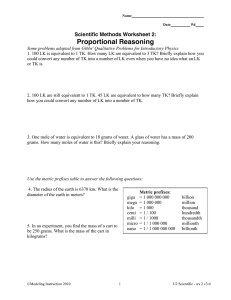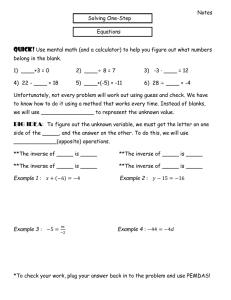Scientific Methods Worksheet 2:

Name __________________ AP Physics 1 Period ___
Scientific Methods Worksheet 2:
Proportional Reasoning and SOLUTIONS
1. One mole of water is equivalent to 18 grams of water. A glass of water has a mass of 200 grams.
How many moles of water is this? Briefly explain your reasoning.
200 g
200 g x
1 mole
18 g
11 mole
By multiplying 200g by the unit conversion (1mole=18g), you are multiplying 200g by one.
That does not change the value of what you started with, just the units.
Use the metric prefixes table to answer the following
Metric prefixes: questions:
2. The radius of the earth is 6378 km. What is the
(G) giga = 1 000 000 000
(M) mega = 1 000 000
billion
million diameter of the earth in meters?
(k) kilo = 1 000 thousand
D
2 R
12756
2 x 6378 km x km
1000
1 km
m
12756 km
(c) centi = 1 / 100
(m) milli = 1 / 1000
(
) micro = 1 / 1 000 000
hundredth
thousandth
millionth
(n) nano = 1 / 1 000 000 000 billionth
12 , 756 , 000 m
1 .
276 x 10 7 m
12 .
76 Mm
3. How many megabytes of data can a 4.7 gigabyte DVD store?
4 .
7 Gb
4 .
7 Gb x
10
9 b
1 Gb
1 Mb x
10 6 b
4 .
7 x 10
3
Mb
4700 Mb
4. A mile is farther than a kilometer. Consider a fixed distance, like the diameter of the moon. Would the number expressing this distance be larger in miles or in kilometers? Explain.
It would be larger in kilometers. Since km are smaller units of measure, you would need more of them to cover the distance than you would need miles
5. Last year, one US dollar = 0.77 Euros. Which is worth more, one dollar or one Euro? Explain.
Euro is worth more since to buy something worth a given amount, you would need to pay more dollars than Euros (only need to pay 0.77Eu vs 1$)
6. In May 2012, Germans paid 1.70 Euros per liter of gasoline. At the same time, American prices were $3.60 per gallon. a.
How much would one gallon of European gas cost in dollars?
1 .
70 Eu / L
1 .
7 Eu
1 L x
0 .
1
77
$
Eu
We have cheaper gas!! x
4 .
1
546 gal
L
10 $ / gal
b. How much would one liter of American gasoline cost in Euros? (One US dollar = 0.77 Euros, 1 gallon = 4.546 liters)
3 .
60 $ / gal
3
1
.
60 gal
$ x
0 .
77
1 $
Eu x
4 .
1 gal
546 L
0 .
61 Eu / L
7. A mile is equivalent to 1.6 km. When you are driving at 60 miles per hour, what is your speed in meters per second? Clearly show how you used proportions to arrive at a solution.
60 mph
60 mi x
5280 ft x
1 m x
1 hr
27 m / s hr 1 mi 3 .
28 ft 3600 s
8. Let y = a/(bx 2 ). In each case listed below, describe how y will change. Explain each response. a. Double a, keeping b and x constant. y will double since there is a DIRECT relationship between y
and a (keeping b and x constant) b. Double b, keeping a and x constant. y will be half as big since there is a INVERSE relationship between y
and b (keeping a and x constant) c. Double x, keeping a and b constant. y will be ¼ as big since y is inversely proportional to the square of x (keeping a and b constant
9. For each of the following mathematical relations, state what happens to the value of y when the value of x is halved. (k is a constant) a. y = kx y will be halved as well since there is a DIRECT relationship between y
and x (k is constant) b. y = k/x
y will double since there is a INVERSE relationship between y
and x (k is constant) c. y = k/x 2
y will be 4xs bigger since y is inversely proportional to the square of x (k is constant)
10. When one variable is directly proportional to another, doubling one variable also doubles the other.
If y and x are the variables and a and b are constants, circle the following relationships that are direct proportions. Explain your choices. a. y = 3x b. y = ax + b this one is linear, not direct. A direct relationship is linear with y-intercept of 0 c. y = x d. y = ax 2 this one is parabolic ( y
x
2
) e. y = a/x this one is inverse ( y
1/x ) f. y = ax g. y = 1/x this one is inverse ( y
1/x ) h. y = a/x 2 this one is inverse square relationship ( y
1/x 2 )
11. When one variable is inversely proportional to another, doubling one variable halves the other.
If y and x are the variables, and a and b are constants, circle the following relationships that are inverse proportions. Explain your choices. a. y = ax this one is direct ( y
x ) b. y = a/x 2 this one is inverse square relationship ( y
1/x
2
) c. y = b/x d. y = 1/(x + b) e. y = ax + b this one is linear f. y = 5/x g. y = x 2 this one is parabolic ( y
x
2
) h. y = 1/x
12. The diagram shows a number of relationships between x and y.
a. Which relationships are direct proportions? Explain. b and e . Both are linear with a 0 intercept ( y
x ) b. Which relationships are inverse proportions? Explain. a . As x gets larger, y gets proportionally smaller, the relationship is reciprocal and gives a hyperbolic curve ( y
1/x ).
COMMON MISTAKE: Note that f is NOT inverse even though y decreases as x increases; it is linear with a negative slope, the relationship between x and y is NOT reciprocal and the graph is NOT hyperbolic c.
Which relationships are linear? Explain. b, d, e and f . a b c d f e







